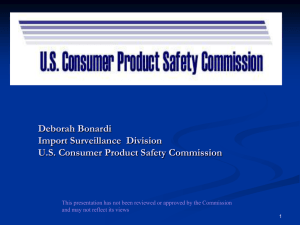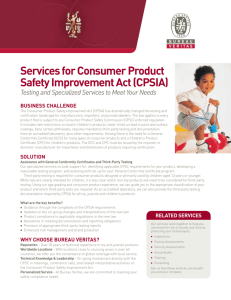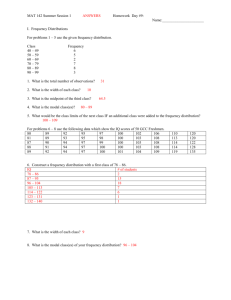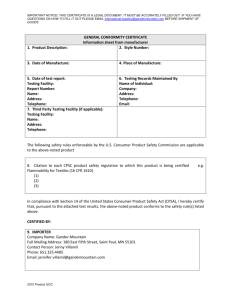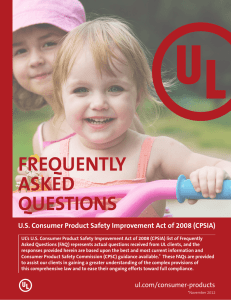Consumer Products Safety Improvement Act Update - BMI
advertisement
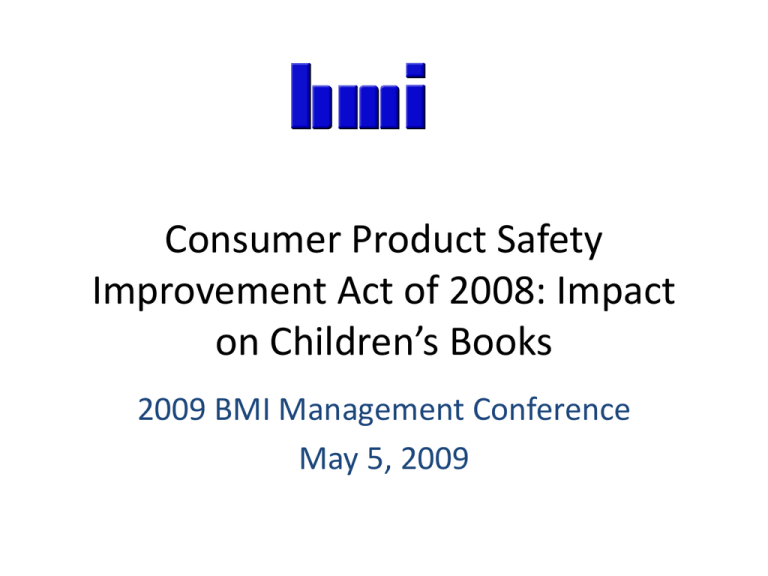
Consumer Product Safety Improvement Act of 2008: Impact on Children’s Books 2009 BMI Management Conference May 5, 2009 Consumer Product Safety Improvement Act of 2008 (CPSIA) • Applies to any consumer products intended primarily for children 12 or younger. • Key areas of concern for book manufacturers: – Lead Paint (does not apply to printed materials) – Lead Content Limits – Phthalates Ban – Testing and General Conformity Certification requirements – Labeling 2 “Total Lead” Ban • As of February 10, 2009, it became illegal under the Act for any part of a children’s product to contain more than 600 ppm (parts per million) total lead content by weight. • The total lead limit will go down to 300 ppm on August 14, 2009. • It will fall further to 100 ppm on August 14, 2011, unless the CPSC determines it not technologically feasible. • Note that the limit is on total lead, not soluble lead. • Retroactive applicability – The lead limits apply regardless of the date that the product was manufactured (i.e., old inventory is no less subject to the limits than products manufactured on or after the implementation dates). 3 Phthalates Ban • Phthalates are certain acidic substances added to plastics to increase their flexibility. • The Act permanently bans the phthalates DEHB, DBP, and BBP in concentrations of more than 0.1% in children’s toys or child care articles. • Pending further study, the CPSIA imposes an interim ban on the phthalates DIND, DIDP, and DnOP in concentrations of more than 0.1% in child care articles or toys that can be “placed in the mouth” within the meaning of the Act. 4 Labeling • Children’s Products manufactured after August 14, 2009 must have the following information (or be able to ascertain the following information): – – – – Manufacturer Name Location of manufacture Date of Manufacture Print run • Task force headed by AAP and BMI is trying ensure flexibility in compliance. BMI Response • Organized task force with the Association of American Publishers. Many leading book manufacturers (including RR Donnelley, Quebecor and Courier) and the largest publishers are active participants. • Lobbied CPSC and Congress for relief. • Test results on RRD website – still need more • Obtained relief from phthalates ban for “ordinary books” • CPSC has delayed the testing and certification requirements for one year – until February 10, 2010. Products manufactured before then are not subject to these requirements, with certain exceptions (such as third-party testing for lead in paint). • Bans and other safety requirements are still in place. 6 Children’s Books with Inherent Play Value • Although “ordinary books” are exempted, the permanent phthalates ban does apply to books that have some inherent play value and constitute toys or have toy-like features. • Examples - a book for use in a bathtub or a book that can be cut into paper dolls. • Children’s books constituting “toys that can be placed in the mouth” would also be subject to the interim ban. More guidance from the CPSC is needed as to what this term means. 7 General Conformity Certificate (GCC) • Will be required after February 10, 2010 unless permanent relief is obtained for books and printed materials. • Must be issued by the importer (when the product is made outside the U.S.), or the manufacturer in the case of products made within the U.S. 8 What Must be Included in the GCC: • See the form developed by BMI and the task force participants. • Needs to include: – – – – – – Each product safety regulation certificate covers. Identification of the importer or domestic manufacturer. Contact information Date and place of manufacture. Date and place of testing. Identification of any 3rd party testing laboratory. 9 Basis for the Certification • The GCC may be based on a test of each product or “a reasonable testing program” prior to August 2009. In response to lobbying efforts, CPSC has indicated that such a program: – Does not require third party testing; – Can be based on X Ray Fluorescence technology if used reliably; and – May be based on testing of all components. • Unclear whether a reasonable testing program will be sufficient in February 2010. • Continue testing despite the stay. 10 To Whom Must the GCC be Provided? • The importer or domestic manufacturer must furnish the GCC to all distributors and retailers that it deals with. • All shipments of the product by the importer or domestic manufacturer must be accompanied by the GCC. • The above requirements may be satisfied through print means, or electronic means (such as the inclusion of a unique identifier for finding the GCC on a web site). – Practical issues • IT requirements • Shipping documents 11 Remember: GCCs Will Not be Required Until Feb. 10, 2010 • GCC issuance requirements for total lead content were scheduled to take effect on February 10, 2009. However, on January 30, the CPSC voted to stay enforcement of lead, phthalate, and mandatory toy standards testing and GCC requirements for most products governed by the Act (including children’s books) until February 10, 2010. • The purpose of the stay is to give the Commission more time to make various determinations that may provide relief for certain materials and products from the lead testing and certification requirements, as well as to provide more guidance on when and how testing must be conducted. 12 Third Party Testing • The Act imposes an additional third-party testing requirement for all children’s products. • Importers and domestic manufacturers will have to have their products tested by accredited independent testing labs as basis for GCC’s. 13 Relief for Books – post 1985 • Retailer and Distributor remained concerned the distribution and sale of children’s products that exceeded the lead limits was still prohibited. • In response to lobbying efforts by BMI, AAP, and retailers, on February 6, the CPSC indicated it would not prosecute anyone for manufacturing, importing, distributing, selling, or offering for sale an ordinary children’s book printed after 1985 on the basis that it contains more than 600 ppm lead absent actual knowledge of a violation or after being put on notice about it by the Commission staff. 14 What do we need to do? • The task force headed by AAP and BMI has asked the CPSC to make a formal determination that ordinary children’s books – as well as the component materials (paper, inks, coatings, adhesives, and bindings) that are representative of those used in the printing and manufacturing of ordinary books and other paper-based, printed children’s products (such as bookmarks, posters, flash cards, school tests, etc.) – do not exceed the lead limits contained in the CPSIA. – Novelty books not covered by request. • In support of its request, the task force has supplied the CPSC via posting on the RRD website with more than 400 test results for total lead content – over 300 test results for different finished books, and over 150 test results for all major types of component materials, both domestic and 15 foreign, that comprise such books. Book Industry Test Results • The results consistently showed total lead content as non-detectable or at around 10 ppm which, given the limitations of the tests, is another way of showing total lead content as non detectable (and, in any case, far below the lowest limit prescribed by the CPSIA – 100 ppm – which will not become effective until August 2011). • Need more data on pre 1985 books. 16 Effect of a Favorable CPSC Decision • The task force headed by AAP and BMI is currently awaiting the Commission’s decision. • Unclear at this stage what form the relief will take and whether it will satisfy all constituencies: manufacturers, publishers, retailers and consumers. 17 What Individual Book Manufacturers Should Do • Consult your counsel. • Submit additional testing data. • Watch for BMI updates. 18

